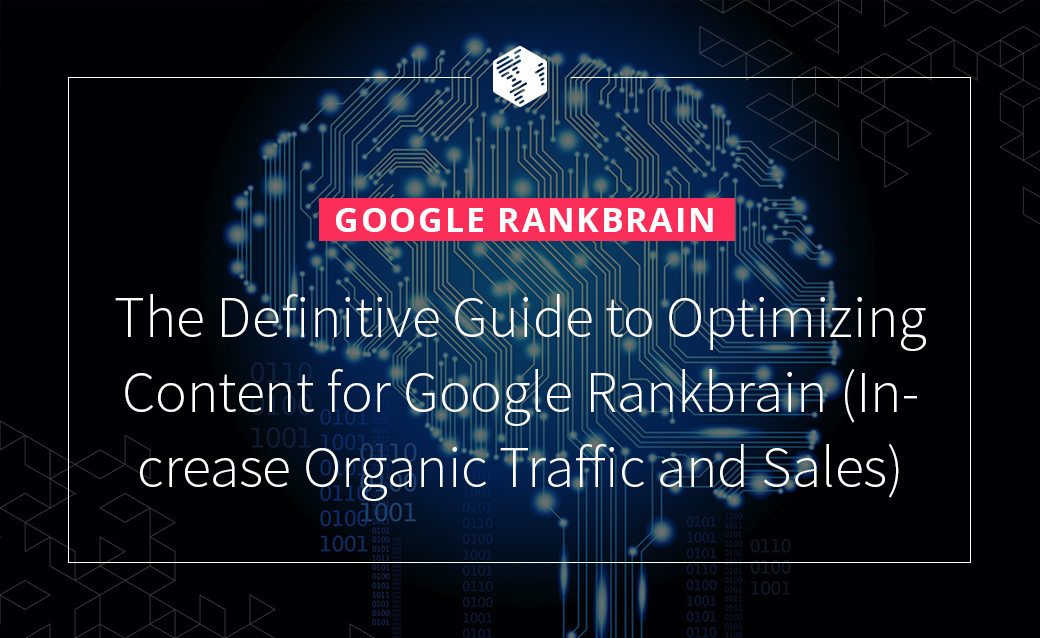Table Of Contents
When Google introduced RankBrain in 2015, it was a new development that made many SEO experts pay attention.
What did it mean for SEO?
How does it affect your website rankings?
And when you consider that Rankbrain is the third most important ranking signal, you’d like to pay attention to how you can ensure you optimize your content for this signal.
In this guide, we’ll go through all the details you need to know to ensure that you boost your page rankings in the RankBrain world.
But before we go on:
What is Google RankBrain?
RankBrain is Google’s machine learning system that helps Google to understand new search terms and provide the right results for the searcher.
Essentially, this artificial intelligence system looks for search terms that have been used in the past similar to this new search term.
But why would Google be worried about new search terms? That is because new search terms make a huge portion of its daily searches. In fact, 15% of Google daily searches are entirely new search terms.
When you consider that Google handles over 2 billion searches daily, new search terms form a big portion of daily searches.
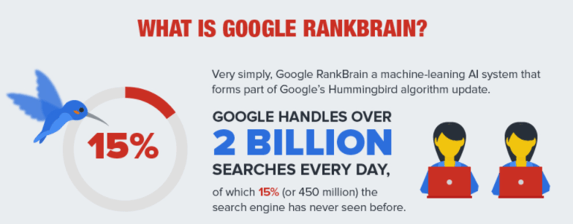
Apart from this, Google Rankbrain also employs user signals to arrange search results. How do people interact with a particular result? Does their interaction show they’re satisfied with the page? If yes, the page is moved up the rankings. If no, the page is pushed down.
Two major metrics that Google Rankbrain uses are:
-
Click-through rate (CTR)
-
Dwell Time (*more possibly)
When more people click-through a particular result than other results on the search results page, Rankbrain will pay attention and move this site higher.
Another is the amount of time they spend on your website which is the dwell time. When people stay for a long time on a page and fail to come back to the results page to click another result, this tells Rankbrain that the page has provided value to the searcher.
If this happens over and over, then your page rankings will improve as Rankbrain will move it up.
How accurate is Rankbrain?
When Google carried out an internal test between Rankbrain and its search engineers, Rankbrain was accurate about search results 80% of the time. While Google engineers were accurate 70% of the time!
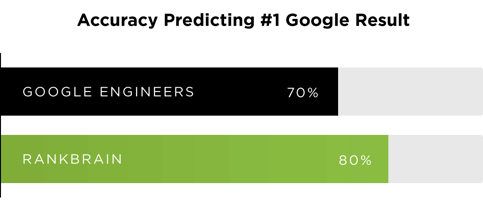
Having explained a bit about how Rankbrain functions and what it does, let’s go into the steps you need to take to optimize your website for Google’s machine learning system.
Steps to optimize your website for Google RankBrain
To ensure that you take advantage of Rankbrain, you’ll need to pay attention to some practices on your website and watch out for some metrics on your pages. These practices have been explained in details below.
1. Target medium-tail keywords
If you’ve been optimizing your website for keywords, you’ve probably heard about head and long-tail keywords. However, another kind that you need to take note of is medium-tail keywords.
As the name suggests, a medium-tail keyword is between a head keyword and a long-tail keyword. This means medium-tail keywords contain more words than head keywords and has lower search volumes.
Likewise, medium-tail keywords contain fewer words than long-tail keywords and higher search volumes. Why does targeting medium-tail keywords make sense?
The way Google produces results is shifting from its old practice. In the past, Google only looked for the presence of a keyword on a page.
Now, it seeks to understand why the searcher is using that keyword and provide results that will meet their intent.
Targeting medium-tail keywords mean your keyword is long enough for Rankbrain to understand it. If you create detailed content around this keyword, then you’ll naturally rank for many long-tail keywords so far Rankbrain thinks your content can meet the users’ needs.
See an example of medium-tail keywords below:
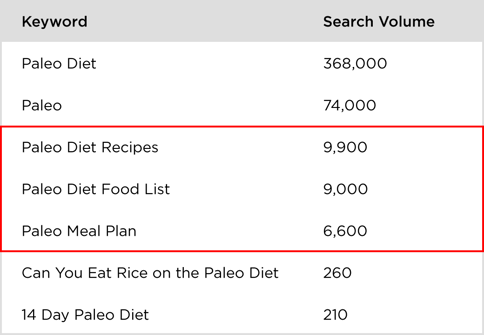
Creating detailed content around this keyword will mean that apart from ranking for that keyword, you’ll also rank for many long-tail keywords similar to it.
2. Understand the searcher intent behind keywords
As I mentioned earlier, simply including keywords in your content won’t make it rank for those keywords.
Before you rank for a keyword today, you need to meet the searcher intent behind the keyword.
There are many reasons people use the keywords they use. And you need to understand these reasons if you must provide content that meets their needs.
Generally, keywords are grouped into 4 types based on searcher intent. These are:
a). Navigational keywords
These are keywords that people use when they’re looking for a specific page online. Examples of this are search terms like “Amazon” or “Facebook login.” The goal of this keyword phrase is to reach a particular site.
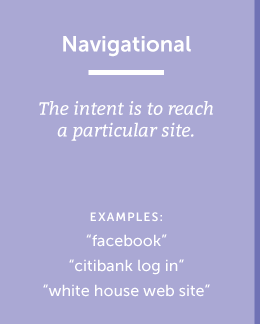
In most cases, these are brand names and the results will usually display the relevant page at the top of the results. Usually, you don’t need to target this type of keywords.
If someone is searching for your brand name, then you’ll likely rank at the top.
Except your brand name is generic. Likewise, it’s difficult for Google to rank your page ahead of a competitor’s page if the searcher used your competitor’s brand name.
This is simply because your competitor’s page is the most relevant result for the search term. Having said that, you can still see marketers target their competitor’s brand name for paid advertising.
b). Informational keywords
These are keywords that indicate a searcher is looking for information about a topic.
This is probably one of the most common types of keywords that people use daily. Some examples could be “how to make a cake” or “world’s tallest mountain.”

The searcher intent for these keywords is usually met by content types like:
-
How-tos
-
Guides
-
Listicles
A point to consider when targeting an informational keyword is: can potential customers use this keyword during their research process?
Another point to consider is if the keyword will attract clicks. Some popularly known information are usually answered on Google search result page. And when this happens, a user has no reason to click-through to your website.
That is why apart from search volume of a keyword, you also need to check it’s click-through rate.
If its click-through rate is unusually low, it could be that Google is already providing the answer that the searcher needs. If you rank for such a keyword, you’ll get low organic traffic from it.
Consider a keyword like “donald trump age.”
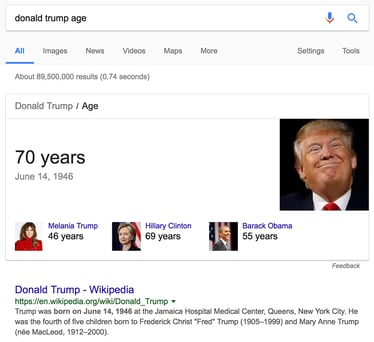
You can see that Google already provides the answer to this question on its search results page. When you put this keyword in the Ahrefs keyword tool, you’ll find that it has a search volume of 121K which is good. But the click-through rate is only 14%.
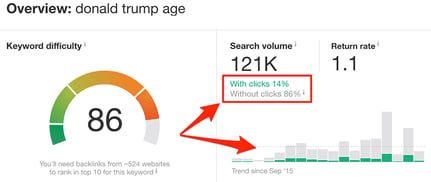
c). Commercial keywords
These are keywords that show a searcher is considering paying for a product or service. But they’re yet to settle on a particular product.
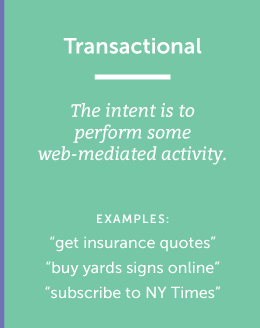
It’s similar to transactional keywords and you could gain a customer at this stage if you produce detailed content that helps to explain what they need. In most cases, a searcher might be making product comparison.
For instance, when a searcher searches for a keyword like “best wristwatch,” what are they looking for? Do they want you to mention a single wristwatch and explain all its details?
No.
They want to see a comparison of many wristwatches and they can then make a choice based on their preferences.

If you’re targeting such a keyword, you need to provide a list of the best wristwatches and explain the pros and cons of each wristwatch on the list.
A searcher should be able to come to this page and find it easier to select a wristwatch that meets their needs.
In this case, the searcher could be a potential buyer in the future. That’s as soon as they make a choice of the product to go for.
d). Transactional keywords
These are keywords that show that a searcher is ready to buy a product or pay for a service.

Usually, transactional keywords are usually accompanied by words like:
-
Buy
-
Purchase
-
Plans
-
Free shipping
-
Discount
This could be used together with other words relevant to your business. For instance, a searcher who wants to pay for Buffer’s service could use the keyword “Buffer plans.”
See an example of search results for “Buy Rolex wristwatch.”
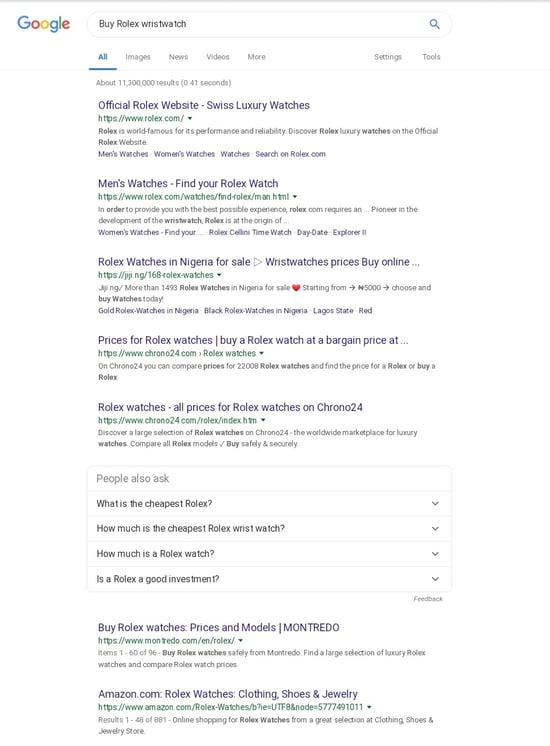
The main point about understanding searcher intent is that it helps you to produce pieces of content that will engage your visitors. Likewise, you can provide value and keep them longer on your website.
When you achieve this, Rankbrain will reward your page with a higher ranking and you can get higher organic traffic.
3. Write better headline to increase CTR
Your post headline is one of the most important parts of your page. Whether on your homepage, or social media, or search engine results page, your headline will determine whether people will click-through to visit your page.
Legendary copywriter, David Ogilvy, claims that on average, only 2 out of 10 people who see your headline will click to read the post. As a matter of fact, you want to perform above average with your headline as it could affect your click-through rate.
What are some ways to improve your headline?
i). Preach benefits: Someone putting a search term in the search engine is looking to solve a problem.
If there are little indications in your headline that they’ll find a solution to their problems on your page, they’ll scroll down to another result.
It’s important to think of the benefit a searcher is looking for and promise this benefit in your headline.
ii). Add emotional words: This type of words is attractive to people. In fact, CoSchedule found in a study that headlines with emotional words tend to perform better than ones without emotional words.
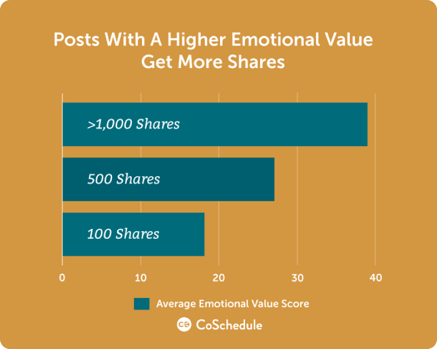
iii). Make it as short as possible: If your headline is too long, Google will cut it off and searchers will only be able to see a part of it. Short headlines that go straight to the point tend to perform better for readers.
Apart from an attractive headline, other parts of your page you need to optimize to improve click-through rates are:
iv). URL: This is part of your page that a searcher sees on the search results page. Even though many tend to overlook it, you should pay attention to it just like you do to your headline and meta description.
It’s important to use an SEO-friendly URL structure to help search users understand what your page is about. You should have your target keyword in your page URL. See an example of an SEO-friendly URL below:
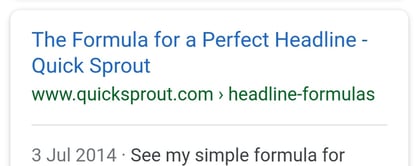
Of course, it’s possible to see websites like Entrepreneur rank high on search engines despite having URLs that are not SEO-friendly.
You have to note that these websites are authoritative websites and most people already know and trust them.
v). Meta description: This is a brief summary of what your post is all about on the search engine results page. Your meta description could convince searchers to click-through to your page if you arouse their curiosity.
Also, you should have your target keyword in your meta description.
When you do this, Google will make the keyword bold if a searcher has used the exact keyword. This helps to show a searcher that your page is actually relevant to their search.
4. Produce great content to increase dwell time
If you want to keep searchers on your website and provide value, you need to produce great content on your website. There are no two ways about that.
How do we define great content?
This is a piece of content that’s able to provide a solution to the problem a page visitor is looking to solve.
When a searcher visits your page and they find a solution to their problem, they’ll stay longer on your page and won’t return back to the search page.
This is a signal to Rankbrain that your page is providing value. One of the important metrics that Rankbrain looks for is dwell time.
If a searcher spends 5 seconds on a page and returns to the search results to click on another result, it means the first result didn’t provide value.
However, if they enter a page and spend a minute or two reading the content, Rankbrain sees that as the page providing value. As a result of this, such a page will see a boost in their rankings.
How do you create great content that helps you to keep more of your readers longer on your web page?
i). Write long-form content
Over the years, long-form content has been proven to perform better than short content on the search engine results page. But if you’re only thinking of length, you need to reconsider.
The length is a correlation and not a causation. This means you could have a long piece of content and still have a low search engine ranking.
So why should you write long-form content? Because it allows you to include as many details as possible to tackle your topic effectively. This increases the chances that a visitor to your web page will find the information they’re looking for and stay longer on your page.
ii). Use subheadings, short sentences, and paragraphs
While having long-form content is great, you’ll agree with me that it can be more difficult to read than short-form content. But you can make it easier for your visitors.
The reality is that only a few people will read the whole page content. In fact, a study found that on average, visitors will only read 20 to 28% of your page content.

You can make it easier for your visitor to read your content if you format it for easier reading. And for people who want to read only a part, you can help them find that part easily.
To achieve that, you have to:
a). Use subheadings: this helps to divide your content into different points you want to make. To make your subheadings easier for visitors, you should ensure that each of your subheadings should contain less than 300 words.
b). Use short sentences: this type of sentences is easier to comprehend. As a result of this, visitors find it easier to go through. You can go through your content and look for long sentences.
You’ll find that you can break them into 2 or more sentences. 15 or fewer words in a sentence should make for easier reading for your visitor.
c). Use short paragraphs: a lot of white space on your page help readers go through it faster. And you can only achieve that through short paragraphs.
You should keep your paragraphs between 2 to 3 sentences to ensure an easier reading.
d). Use bullets: when making a list, it’s easier to use bullets to display all the components of your list. Another advantage is that it pulls attention. For people skimming through your content, they pause and see what your list is about.
This can keep them longer on your page and consume more content.
iii). Create conversational content
Nowadays, people have grown impatient. And this is because technology has trained people to be. It extends to creating your content too.
You don’t want to have too many technical jargon in your content. Because it will get boring fast and lose your visitors. When visitors come to your website through search engines, they want to have a conversation with you.
Conversational content helps your visitors feel that you understand the issues they’re going through. With this type of content, you can walk them through their frustrations and provide the solutions to it.
Furthermore, conversational content is just easier to read. It connects better with your audience and helps you to get your message across.
In fact, conversational content is so important that Google’s webmaster trends analyst, Gary Illyes, said that writing conversational content is the way to optimize your content for Rankbrain.
He said:
“If it sounds conversational, if it sounds like natural language that we would use in your day to day life, then sure, you’re optimized for Rankbrain.”
Having said these, how do you write conversational content? You have to consider your reader’s perspective. What is their problem? Why do they have this problem? Why are they looking to solve the problem?
After answering these questions, imagine you have your reader in front of you. Or better still, imagine your reader is your friend and you have to explain this topic to them in a way they’ll understand.
Write this way and you will have produced a piece of content that’s conversational.
iv). Repurpose content
The most popular type of content is written content. But other forms of content are becoming more popular by the day.
At this period of time, only producing written content might be insufficient in attracting and keeping visitors on your website. Another thing you want to consider is how easy your content is for your readers to consume.
In some cases and for some functions, other formats might be easier for your visitors than the written content.
In fact, a study found that people who read text only remember 10% of it 3 days after reading while people who view visual content remember 65% of it after the same period.
What are some other content formats you should explore to attract and keep more visitors on your website?
i). Videos: they help to provide a visual explanation of a topic to your audience. You’ll find that some topics, especially tutorials, are easier to explain using videos.
This way, you can show each step and your audience can follow these steps to carry out a particular task.
In fact, some Google searches today have videos as their first result. For these searches, Google may indicate a snippet of the video that meets the searcher intent. For instance, look at the example below:
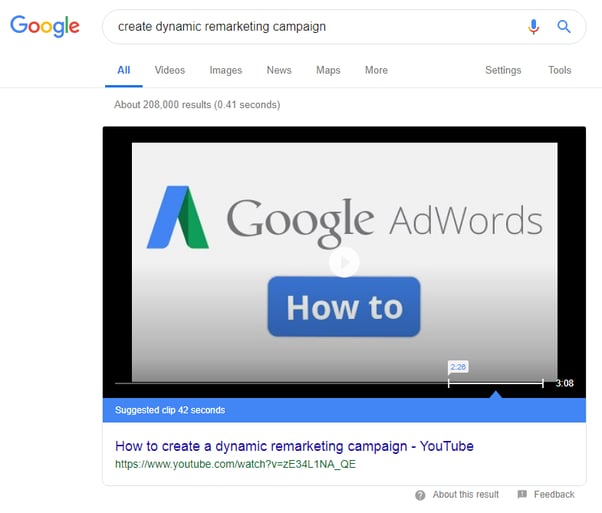
This is why creating videos should be a part of your content strategy to take advantage of Rankbrain. Another point to consider is that YouTube is currently the second largest search engine.
When you optimize your videos on this website, you increase your reach and can as well rank for relevant keywords on Google.
ii). Infographics: this uses illustrations to simplify complex concepts. Infographics are a type of content that attract high engagement from users and also share it more on social media.
In a survey, 40% of marketers said original graphics drove the highest level of engagement.
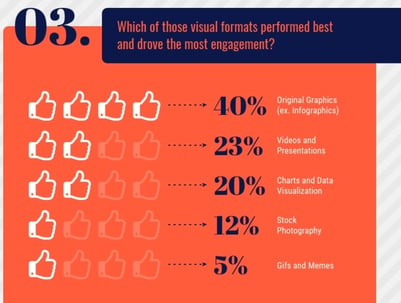
Added to that, infographics can show up in Google image search. Another possible benefit of infographics is that it can help you gain more backlinks to your website and increase your page authority.
iii). Podcasts: for visitors who might need to consume your content while doing other things, a podcast is a viable type of content for these people.
Some people like to listen to content while doing their exercise routines or while driving and this can help them to consume more content while their hands are busy.
Podcasts have become popular over the years in the United States. A study by Edison Research and Triton Digital revealed that 26% of Americans listen to podcasts monthly. That’s about 73 million Americans.
iv). Webinars: this is a form of a seminar that is carried out online. If you’ve created a guide about a topic in your industry, you can organize a webinar to teach people about the important concepts they need to know.
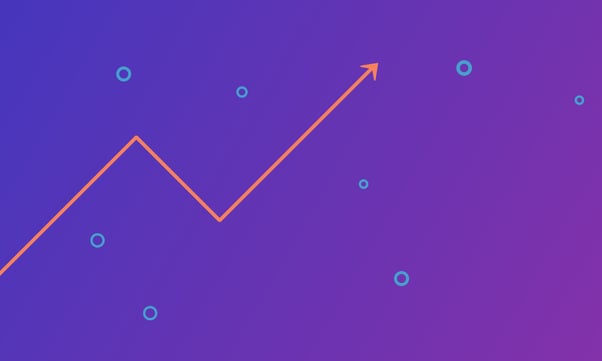
Source: BigMarketer
An edge that a webinar has over regular videos is that it allows for interaction between the host and the attendees.
Attendees can ask questions while a webinar is going on and the host can answer these questions.
v). Slides: these contain a series of images that are used to explain a topic. Viewers can go through slides to get a summary of what a topic is all about.
5. Use internal linking
One of the most underrated ways of keeping visitors on your page is through internal linking. This involves interlinking between your web pages. Internal linking carries out 3 important functions on your pages:
-
It helps to keep your visitors on your page for longer periods of time as they visit other pages through your internal links.
-
It helps to provide more value as visitors can find more pages on your website that make your website a big resource in your niche.
-
It helps search engine bots crawl your website more effectively.
When you look at it from the point of website usability and satisfying searchers, internal linking is a no-brainer. Rankbrain wants to rank results that can satisfy searcher intent and keep searchers on their website.
No matter how detailed your content is, it can’t explain everything in your niche.
You probably have other posts on your website where visitors can get more details about some related topics. This helps you to reduce bounce rate on your web page and increase dwell time.
These are all positive signals that will make Rankbrain push your page up the rankings.
One example you can look at is Wikipedia. See this portion of a page on Wikipedia with 4 internal links:
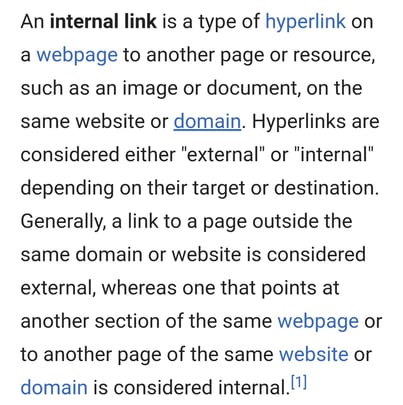
Perhaps it’s no wonder that Wikipedia ranks for so many keywords.
6. Improve website user experience to reduce bounce rate
One of the signals Rankbrain uses is how visitors from search engine interacts with your website.
If a searcher visits your website and returns to the search results page in a few seconds to click on another result, it tells Rankbrain that your page isn’t providing value.
This will cause your page to get lower rankings as Rankbrain will reward the page providing value with higher rankings.
However, one big mistake you can make is thinking that only great content will keep a visitor on your website.
A major factor that will determine whether searchers stay on your website or not is your website user experience.
If you offer a poor user experience on your website, visitors won’t stay long enough to take advantage of your great content.
The following are the few ways you can improve your website user experience:
i). Improve your website speed
When people click on your website page today, they want to see your page content as soon as possible. If your page takes ages to load, the situation you’ll have is many people bouncing from your website.
In fact, a Google study revealed that the probability of a user bouncing from your website would have risen to 32%. People expect your website to load fast. Slow loading speeds could see them flee your website.
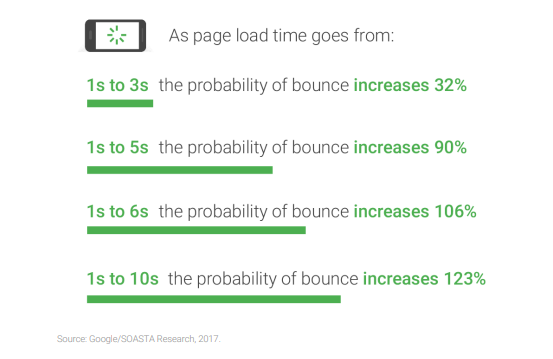
When this happens, your website will have a high bounce rate. All this tells Rankbrain is that your page is providing little value to searchers. And for that, your page is pushed down the rankings.
However, to improve your website speed, you need to know your current speed. You can get this information through speed tools that help to test your website speed. Some of these tools are Pingdom, Google page speed insights, GT Metrix, etc.
Let’s consider how you can use Pingdom. This is the most popular speed test tool you can find online today. To use the Pingdom tool, navigate to its website.
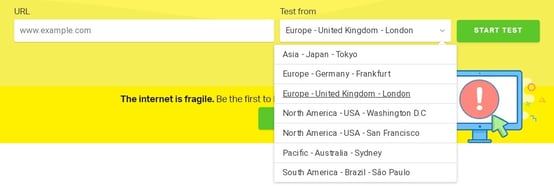
On this page, you can enter your website address and select the server you want to test your website from. The tool has 7 servers in 5 continents.
To select a server, ensure that you select one that’s closest to where you have the major share of your visitors.
After doing this, click on the “Start Test” button to begin your test. The results will show you important details like your page load time, number of requests, page size, performance grade, etc.

You can also find more details about your website speed with the performance insights. This will show you how your website performs in various aspects.

When you click on each of this performance breakdown, you’ll see recommendations that you can follow to improve this aspect of your website.
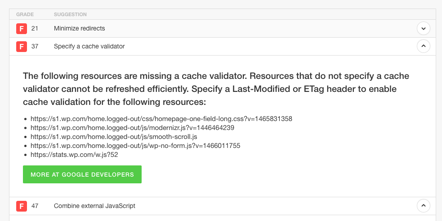
When you have a knowledge of your website speed, you can take different optimization steps and see how they affect your speed. You can also carry out this test to see how your page speed is improving.
Some steps you can take to improve your website speed are:
-
Use a fast website host
-
Use a content delivery network
-
Minimize your image size
-
Minify your website code
-
Use Google accelerated mobile pages (AMPs)
Increasing speed is vital to keeping your visitor on your website and you should ensure you do this.
ii). Improve website mobile-friendliness
More searches are now carried out on mobile devices. In fact, a study found that 60% of Google searches are done on mobile devices.
If your website is difficult to access on mobile devices, many mobile searchers will bounce away from your website. In this situation, your rankings will plummet as Rankbrain will see your page as a poor page.
You can find out if your website is mobile friendly by using the Google mobile-friendly tool. Enter your website address into the tool and click on “Run Test.”
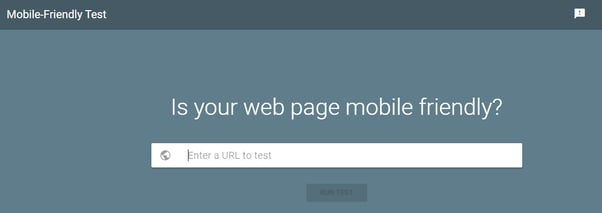
You’ll see the result which will indicate whether your website is mobile-friendly or not.
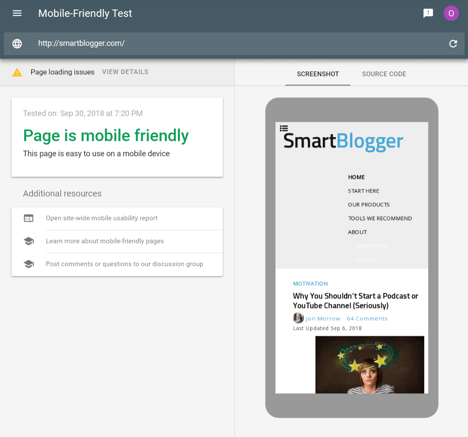
If you click on “More details,” you’ll see more details about your website mobile friendliness and what you can do to improve it.
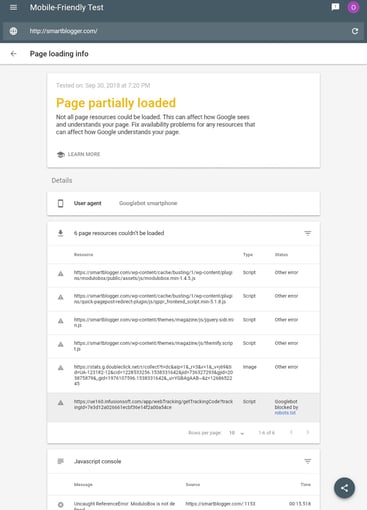
How do you make your website mobile-friendly?
The easiest way to achieve mobile-friendliness is to use a mobile-responsive them on your website. This ensures your website will adapt to any screen on which it’s viewed.
Conclusion
To optimize your content for Google Rankbrain, you need to understand that this machine learning system is all about trying to show the best results possible for Google users.
This means you need to optimize your presence on search engine results page to attract more clicks and you need to satisfy visitors with great content and website user experience.

